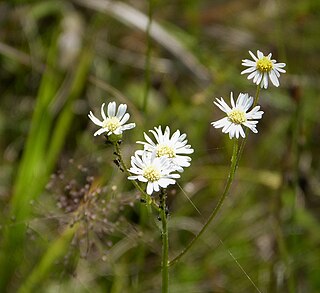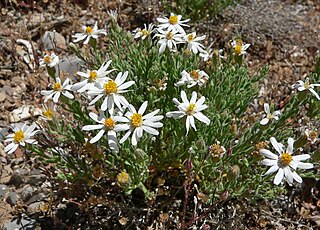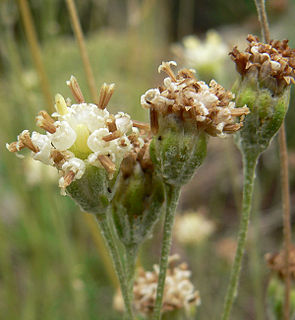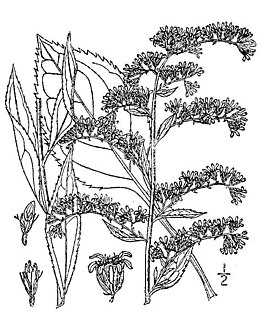
Helianthus is a genus comprising about 70 species of annual and perennial flowering plants in the daisy family Asteraceae commonly known as sunflowers. Except for three South American species, the species of Helianthus are native to North America and Central America. The best-known species is the common sunflower, whose round flower heads in combination with the ligules look like the Sun. This and other species, notably Jerusalem artichoke, are cultivated in temperate regions and some tropical regions as food crops for humans, cattle, and poultry, and as ornamental plants. The species H. annuus typically grows during the summer and into early fall, with the peak growth season being mid-summer.

Boltonia diffusa, the smallhead doll's daisy, is a North American species of plants in the family Asteraceae. It native to the United States, primarily the states along the Gulf of Mexico from Texas to Florida plus the lower Mississippi Valley from Louisiana to Illinois. There additional populations in the eastern United States as far north as Virginia.

Iva is a genus of wind-pollinated plants in the family Asteraceae, described as a genus by Linnaeus in 1753. Plants of this genus are known generally as marsh elders. The genus is native to North America.

Chaetopappa is a genus of plants in the family Asteraceae which are known generally as leastdaisies.

Hymenopappus is a genus of flowering plants in the daisy family. Many species are known as woollywhites.

Hymenopappus filifolius is a North American species of flowering plant in the daisy family known by the common names fineleaf hymenopappus and Columbia cutleaf. It is native to western and central North America from Alberta and Saskatchewan south as far as Chihuahua and Baja California.
Tetraneuris scaposa is a North American species of plants in the sunflower family. It grows in the southwestern and south-central United States and northern Mexico.

Orbexilum pedunculatum, commonly known as Sampson's snakeroot, is a species of flowering plant in the legume family. It is native primarily to the Southeastern United States where it is found in prairies and savannas, often in acidic soil. It is a perennial that produces racemes of flowers in early summer.

Solidago arguta, commonly called Atlantic goldenrod, cut-leaf goldenrod, and sharp-leaved goldenrod, is a species of flowering plant native to eastern and central North America. It grows along the Gulf and Atlantic states of the United States from Texas to Maine, inland as far as Ontario, Illinois, and Kansas. It is primarily found in areas of woodland openings, such as outcrops or clearings.
Brickellia lemmonii, or Lemmon's brickellbush, is a North American species of flowering plants in the family Asteraceae. It is native to northeastern and north-central Mexico and the southwestern United States.
Erigeron bellidiastrum, the western daisy fleabane or sand fleabane, is a species of fleabane in the family Asteraceae. It is native to northern Mexico and the western and central United States.

Gaillardia suavis is a species of flowering plant in the sunflower family, common names pincushion daisy and perfumeballs. It is native to northern Mexico and the southern Great Plains of the United States.
Haploesthes greggii, common name false broomweed, is a North American species of flowering plants in the family Asteraceae. It grows in northeastern Mexico and in the south-central and southwestern United States.

Hymenopappus artemisiifolius, the oldplainsman, is a North American species of flowering plant in the daisy family. It has been found only in the south-central United States, in Texas, Arkansas, and Louisiana. Its natural habitat is in sandy soils of prairies and open woodlands.
Hymenopappus biennis, the biennial woollywhite, is a North American species of flowering plant in the daisy family. It has been found in New Mexico and western Texas.
Hymenopappus carrizoanus, the Carrizo Sands woollywhite, is a North American species of flowering plant in the daisy family. It has been found only in Texas, on the Carrizo Sands of the central part of the state.
Hymenopappus flavescens, the collegeflower, is a North American species of flowering plant in the daisy family.

Hymenopappus mexicanus, the Mexican woollywhite, is a North American species of flowering plant in the daisy family. It grows in northern Mexico and the southwestern United States.
Hymenopappus tenuifolius, the Chalk Hill hymenopappus, is a North American species of flowering plant in the daisy family. It grows in the central and southeastern United States, primarily on the Great Plains from Texas and New Mexico north as far as South Dakota.
Tetraneuris linearifolia is a North American species of plants in the sunflower family, known by the common name fineleaf fournerved daisy. It grows in the south-central United States and northern Mexico.











